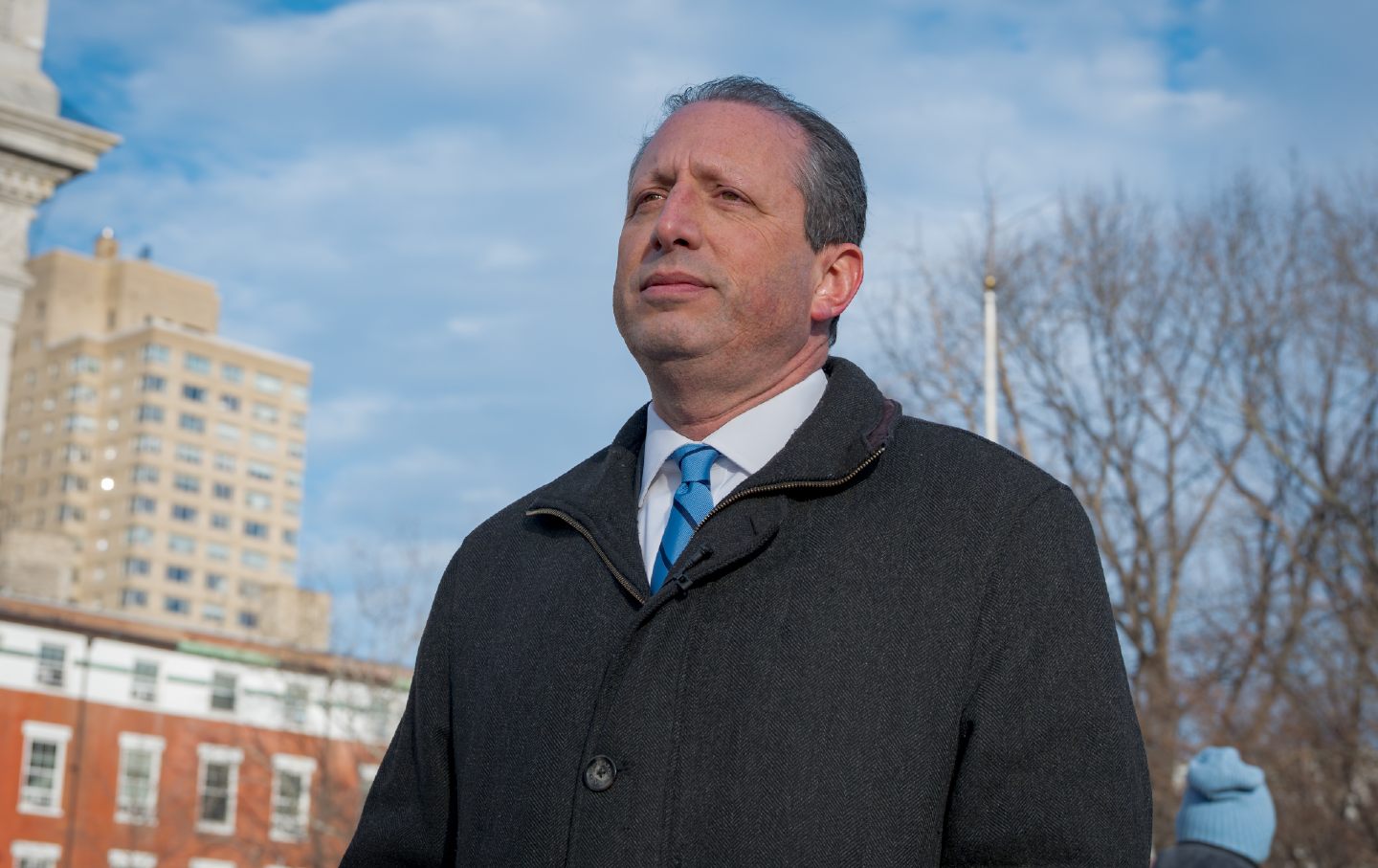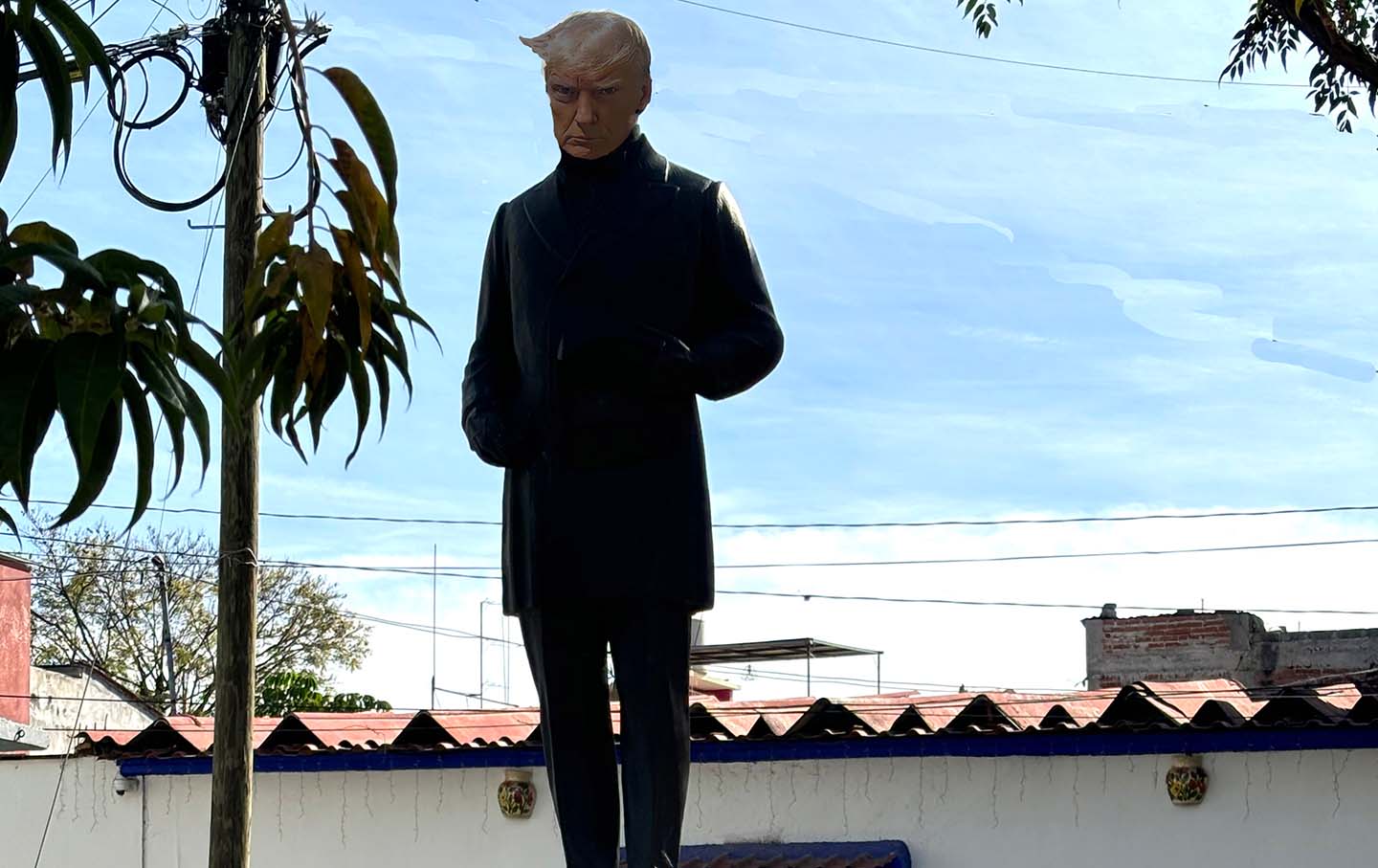What We Learn From the Texas Town That Voted for Abortion and for Trump
The right to abortion won big this election—and so did the man who ended Roe v. Wade. Nowhere was that contradiction more pronounced than in Amarillo, Texas.

Amarillo, Tex.—In the Texas panhandle city of Amarillo on Election Day, in the buckle of the Bible Belt, Dexie Organ, 60, dressed in black leggings and a red shirt, stepped out of her beat-up Nissan and headed across the parking lot to vote. On her way, she saw a volunteer holding a sign that read: “Vote No on Prop A.” Organ stopped. “I need a little education,” she told the sign-holder, Diann Anderson, who explained to her that Proposition A was an abortion travel ban that would deputize private citizens to sue anyone they suspected of helping someone travel through Amarillo to get an abortion out of state. “I do believe that is unconstitutional,” Organ told me. “We’re women; I don’t know why they think they need to suppress us.” Organ told me she has 14 children—and she’s had an abortion. “I have eight daughters…and I want them to have what they want,” she told me.
So Organ went inside and cast her ballot against the ordinance—and in favor of Donald Trump.
Across the country, a critical mass of voters made this seemingly contradictory choice along with Organ: The same electorate that voted for abortion rights in seven out of the 10 states where they were on the ballot also voted to return Trump, the man responsible for overturning Roe v. Wade, to office. Abortion rights ballot initiatives won alongside the most conservative of Republicans, like Senator Josh Hawley in Missouri and Tim Sheehy in Montana. Even in Florida, the high-stakes abortion rights ballot initiative won 57 percent of the vote, making it one point more popular than Trump himself; it failed only because Florida has a 60 percent threshold for an amendment to pass, higher than almost any other state. The right to abortion won big this election, yet so did the party that ended that right. Nowhere was the contradiction starker than right here in Amarillo, where the two counties spanning the city went for Trump by 72 and 80 percent, yet a resounding 59 percent of voters defeated an initiative that, among other provisions, sought to create civil penalties for anyone who helps an Amarillo resident travel for an abortion, end the disposal of fetal remains in the city, and revive the 1873 Comstock Act, which bans the mailing of abortion medication.
Related Articles
Dexie Organ had her reasons—including doubts about Kamala Harris.
“I would like to see a woman president, but I just don’t think she’s the one,” she told me. “She’s not strong enough to lead. We’ve got all these foreign wars going on and the men in the other leadership roles in our world would just annihilate us.”
Plus, Organ was struggling economically, she told me, waiting tables and breeding dogs on top of her job as a certified nurse midwife.
“Our country’s in ruins, financially,” she said, and she believed Trump would help.
But the heart of the contradiction is this: She saw Trump’s position on abortion as acceptable because “he gave it to the states”—including her state, where abortion is banned. Trump had convinced Organ and perhaps millions like her that he did not pose a threat to their daughters. White women like Organ, a majority of whom voted for Trump, were willing to go along with Trump’s racism and misogyny, in part because he had convinced them his position on abortion was a moderate one. As for the Amarillo activists who managed to resoundingly defeat an anti-abortion initiative in the heart of Trump country? They won because they managed to convince voters that their cause was a conservative one.
The pro-choice signs I saw at the polling place in Amarillo could have come from the National Rifle Association or the Libertarian Party. “Say no to government overreach,” read one. “Defend our Constitution. Vote against Prop A,” read another. I noticed the same message emblazoned on a white sheriff’s SUV nearby: “Randall County Sheriff. Defending the Constitution.” An organizer against Prop A joked with The New Yorker’s Rachel Monroe about “the conservative hanger”—a door hanger that read “Protect Your Rights” with an eagle and a quotation from (virulently anti-abortion) Governor Greg Abbott that read: “If you want to start a fight with Texans, just try taking away their freedom.”
“We are continuing to find that, regardless of political affiliation, the majority of Amarillo wants to reject this extremist ordinance,” Lindsay London, a nurse and cofounder of Amarillo for Reproductive Freedom Alliance told me as we stood in the parking lot. “They find it to be government overreach, a violation of privacy and freedom.”
The “government overreach” line was so effective that supporters of the anti-abortion ordinance were coopting it, shouting: “Stop government overreach! Vote for Prop A!”
The attempt to frame abortion rights as a conservative issue dates back to at least 1986 when pro-choice campaigners used messaging against government interference to defeat an anti-abortion ballot initiative in Arkansas, as Will Saletan wrote in his book Bearing Right. It’s been recycled across the country again and again. In Missouri, the successful campaign to enshrine a right to abortion until viability in the state constitution was called Missourians for Constitutional Freedom. Kansans used the same name to defeat an anti-abortion initiative there in 2022, and as I wrote then, some voters were so confused by the name they weren’t sure at first which side of the issue the canvassers were on. This year, a spokesperson for Arizona’s successful abortion rights ballot initiative campaign told The New Yorker they were counting on Republican voters for whom the issue “goes in conjunction with their conservative values—they don’t want the government in the doctor’s office with them.” As I reported, Floridians Protecting Freedom sought to peg that state’s six-week ban to the unpopular “government overreach” that angered Floridians during the Covid pandemic. “Do not attack Republicans (including DeSantis or Trump) directly,” internal guidance sent to supporters by the campaign urged. “Instead, refer to ‘extreme politicians’ who banned abortion.”
So is it any wonder that voters like Dexie Organ felt they had permission to vote for abortion and Republicans? Campaigns like the one in Amarillo had met voters where they were, allowing them to vote against anti-abortion restrictions in a way that felt consistent with their conservative values. Perhaps, at least here in the Bible Belt, it was the only way to win. And it had worked—on voters like Bailey Odom, 22, a redhead with a ponytail who voted against the anti-abortion ordinance because she felt traveling to get an abortion should be a matter of “personal opinion,” and because her mom had cautioned her that the initiative would create “a whole bunch of snitches” who could file lawsuits to enforce it. “If you want to travel out to do it, that’s what you’ve really got to do, then go ahead,” she said. Odom voted for Trump because “the economy is crap,” as did her dad, Brandon, who voted against the anti-abortion ordinance because “my wife told me to.” Keith Morris, 51, voted against the anti-abortion ordinance and for the libertarian presidential candidate. “A lot of people here have forgotten what being Texan is all about,” he told me. “One thing that being Texan means: You don’t like people in your business, telling you what to do.”
Trump, of course, will now be able to tell us all what to do when it comes to abortion. He could fulfill the promise of Project 2025 and invoke the 1873 Comstock Act to ban the mailing of abortion drugs nationwide, including in the very states that voted to protect abortion rights. The revival of Comstock has become the pet project of Mark Lee Dickson, whose “sanctuary city for the unborn” initiatives have passed in eight counties and 69 cities. Amarillo was Dickson’s latest battleground. After the city council rejected Dickson’s ordinance to empower private citizens to sue anyone who helped someone travel through the city to get an abortion out of state, Dickson and his supporters gathered signatures to put the issue before voters on Election Day. Dickson looked somber Tuesday night as he addressed a few dozen supporters gathered in a local church. “We’ve got to be honest. What happened?” Dickson said. “What happened in Amarillo, Texas?”
The answers to this question were dancing their hearts out in a burger bar across town. The women who had defeated Dickson cheered and threw their arms in the air. Harper Metcalf stood under the glow of the fairy lights and sparkly Texas flag streamers, eyes shining. I’d met her earlier in the day as she sat in her pickup truck outside the polling place with a sign that read “Vote no on Prop A.” She’d been organizing against Dickson for over a year. Now, she seemed to be radiating joy. “How do you feel?” I asked and she looked me in the eye and whispered: “I don’t know if I’ve ever been this happy.” Behind her a TV screen over the bar was tuned to MSNBC. Trump was going to win.
Popular
“swipe left below to view more authors”Swipe →I took a breath and held Metcalf’s joy like a life vest. There would be so much to reckon with in the days and the weeks and the years to come. Soon, data would show what was already becoming clear: that about three in 10 voters in Arizona, Missouri, and Nevada who supported abortion rights ballot measures also voted for Trump. I knew as I stood in that bar that we’d spend years parsing how these initiatives had succeeded where Democrats had failed. One answer is that these campaigns had siloed “reproductive freedom” off the rest of the progressive agenda. They had proven abortion could win in isolation, even in red states, but that these wins would not translate into victories for Democrats. Kamala Harris had failed to articulate a winning economic message that connected reproductive freedom with a sense that Democrats would help struggling people raise the families they did want. Against the backdrop of a loss that felt bottomless, I tried, for a moment, to find the hope.
“A victory is a milestone on the road, evidence that sometimes we win and encouragement to keep going, not to stop,” the author Rebecca Solnit wrote. Her book Hope in the Dark got me through Trump’s first presidency. Victory, she wrote, “is something that has arrived in innumerable ways, small and large and often incremental, but not in that way that was widely described and expected. So victories slip by unheralded. Failures are more readily detected.” I watched Lindsay London leap into the air, throwing her fist over her head. Soak it up, I told myself. You are going to need this feeling. There would be time, later, to count the cards, and face the long fight ahead. There would be time, in every small corner of victory across the country, from Missouri to Amarillo, to rethink the strategy, to consider what winning had cost. But tonight, just for tonight, they were going to revel in their joy.
Support independent journalism that exposes oligarchs and profiteers
Donald Trump’s cruel and chaotic second term is just getting started. In his first month back in office, Trump and his lackey Elon Musk (or is it the other way around?) have proven that nothing is safe from sacrifice at the altar of unchecked power and riches.
Only robust independent journalism can cut through the noise and offer clear-eyed reporting and analysis based on principle and conscience. That’s what The Nation has done for 160 years and that’s what we’re doing now.
Our independent journalism doesn’t allow injustice to go unnoticed or unchallenged—nor will we abandon hope for a better world. Our writers, editors, and fact-checkers are working relentlessly to keep you informed and empowered when so much of the media fails to do so out of credulity, fear, or fealty.
The Nation has seen unprecedented times before. We draw strength and guidance from our history of principled progressive journalism in times of crisis, and we are committed to continuing this legacy today.
We’re aiming to raise $25,000 during our Spring Fundraising Campaign to ensure that we have the resources to expose the oligarchs and profiteers attempting to loot our republic. Stand for bold independent journalism and donate to support The Nation today.
Onward,
Katrina vanden Heuvel
Editorial Director and Publisher, The Nation
More from The Nation

Breaking Democracy Breaking Democracy
Shredding the Constitution and Rule of Law.

This Democrat Is Giving a Master Class in How to Shame the GOP This Democrat Is Giving a Master Class in How to Shame the GOP
A Republican congressman was avoiding his constituents. So Democrat Mark Pocan gave them a chance to speak their mind.

NYC Mayoral Candidate Brad Lander Lays Out His Plan to Uplift the City’s Workers NYC Mayoral Candidate Brad Lander Lays Out His Plan to Uplift the City’s Workers
The New York City comptroller is releasing a workers’ rights platform, which he shared exclusively with “The Nation.”

Making Enemies With the World Making Enemies With the World
Trump’s anti-immigrant position is devastating lives.

The Agony of JD Vance The Agony of JD Vance
The vice president's main job appears to be to embody the banshee scream of a dying order.

14 House Dems Demanded Mahmoud Khalil’s Release. Where Are the Others? 14 House Dems Demanded Mahmoud Khalil’s Release. Where Are the Others?
All members of Congress swore oaths to defend the right to speak freely and assemble to petition for the redress of grievances. Why did so few of them sign this important letter?


